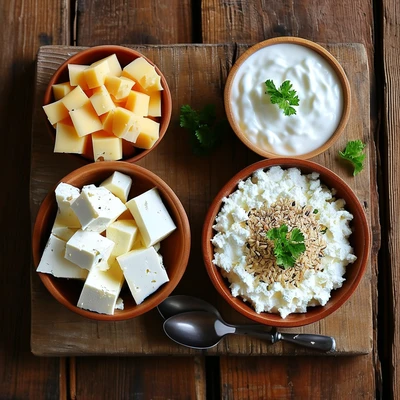Cottage cheese and Greek yogurt are popular dairy products often added to meals to enhance nutritional value. Both are excellent protein sources, but their nutritional profiles have slight differences.
Jump to Key Takeaways.
Generally, cottage cheese has a higher protein content than Greek yogurt.
Both options make for great high-protein snacks.
However, which one is better - cottage cheese or Greek yogurt - depends on personal preferences and specific dietary needs.
Greek yogurt offers a smoother, creamier texture.
Cottage cheese has higher sodium content, making it less suitable for individuals monitoring their salt intake closely.
The nutritional profile can vary based on the type of cottage cheese or Greek yogurt (nonfat, full-fat, or flavored).
- Salt is added during the production process of cottage cheese, leading to a significant sodium content. However, low-sodium varieties are available.
- Beneficial probiotics result from the bacteria used in fermentation for yogurt and Greek yogurt productions. Probiotics support gut health, immune system function, overall wellness, and general health benefits.
Greek yogurt is considered healthier due to its probiotic content and lower sodium levels.
The probiotics found in dairy products like Greek yogurt are associated with a reduced risk of heart disease and may protect against type 2 diabetes.
The U.S. Dietary Guidelines suggest a sodium intake limit of 2,300 mg per day.
Meanwhile, the American Heart Association recommends lowering this to 1,500 mg daily.
A single cup of cottage cheese comprises 47% of your daily recommended sodium if following a 1,500 mg diet.
Excessive salt intake raises blood pressure and raises the risk for heart disease.
Cottage cheese and Greek yogurt undergo different processing methods, which affect their nutritional profiles and sensory aspects.
To produce cottage cheese, milk is mixed with an acid like vinegar. The acid causes separation between solids (curds) and liquids (whey).
The curds are then cut into pieces of varying sizes and cooked to release moisture. Further rinsing and draining reduce liquid content and acidity.
Larger pieces retain more moisture than smaller ones, potentially affecting taste.
Salt is added for flavor enhancement along with cream or thickeners for a smoother texture.
Milk used in yogurt production is heated then cooled before introducing bacterial cultures. It is left to ferment, where bacteria consume the milk sugar and contribute to thickening it into yogurt.
Following fermentation, the yogurt is strained to remove excess liquid (whey), resulting in Greek yogurt.
Greek yogurt features a thicker consistency with higher protein content and fewer lactose and carbs compared to regular yogurt.
Cottage cheese and Greek yogurt both serve as versatile cooking ingredients offering nutritional enhancements.
- Blend with herbs or other components for sauces and dressings
- Beat cottage cheese until smooth and then use it in place of ricotta in lasagnas and pasta dishes
- Incorporate into overnight oats to achieve a pudding-like texture
- Add to smoothies
- Substitute Greek yogurt or cottage cheese for sour cream, ricotta, heavy cream, or mayonnaise on a one-to-one basis
- Use as a substitute in baked goods like cheesecakes or replace some oil amounts with these dairy alternatives in recipes
- Blend with fruits and freeze for nutritious ice popsicles
- Cottage cheese provides higher protein content with 24 grams per one-cup serving but contains more sodium.
- There are slight variations in the nutritional profiles of cottage cheese and Greek yogurt, especially concerning sodium levels.
- Both products offer versatility for use in baked goods, dressings, sauces, or smoothies to add protein and essential nutrients.


